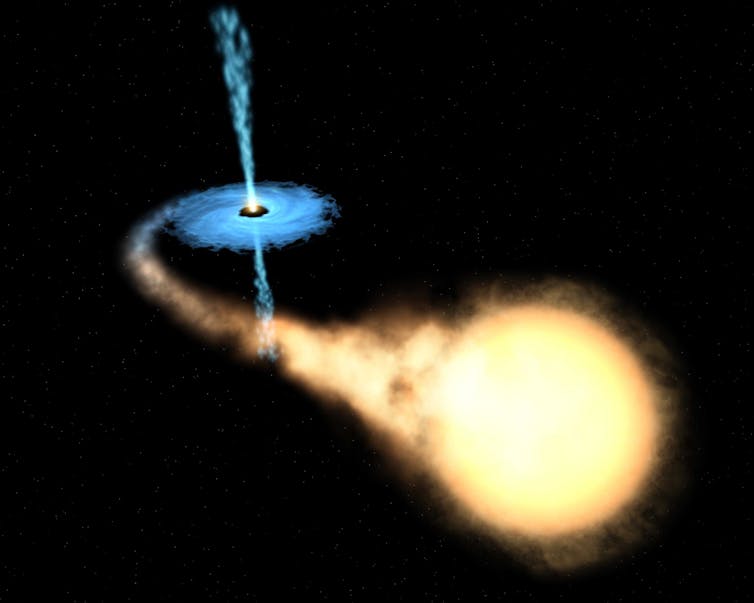Astronomers first noticed an enigmatic object, dubbed “Sagittarius A*”, at the very heart of our Milky Way galaxy in the 1960s – the earliest days of radio and infrared astronomy. But just how extraordinary this source was only became clear three decades later, when it was identified as a supermassive black hole with the mass of whopping four million suns.
Theory predicts that such supermassive black holes, which reside at the centre of most large galaxies, should be surrounded by a cluster of smaller black holes and other objects. But decades of searches have revealed nothing – until now. In a new paper, published in Nature, a team of researchers report the discovery of what seems to be about 13 black holes close to Sagittarius A*.
The discovery of Sagittarius A* was only possible thanks to the first generation of infrared imagers on the best ground-based observing sites in Hawaii and Chile. These could follow the motion of stars very close to the unseen object as they orbited around it. After a decade of observing, complete orbits of stars were mapped out in detail – allowing scientists to calculate the mass of Sagittarius A* with high accuracy.
This work had to be done by looking at infrared light. That’s because, at visual wavelengths, huge clouds of dust and gas obstruct our vision – we can only see about 10% of the distance to the galactic centre in this way (Sagittarius A* is approximately 26,000 light years away). Some infrared light, radio waves and X-rays, however, can penetrate the obstacles in the galaxy to reach our detectors on Earth.

How supermassive black holes grow so large is still controversial. Sagittarius A* is actually fairly small – distant objects of a billion solar masses have been found. One possible explanation is that they are created as galaxies merge or interact – trapping their central supermassive black holes into orbits about each other and eventually merging into an even bigger supermassive black hole.
We know that active star formation is going on in the region of our galactic centre. This will naturally produce copious neutron stars (very dense stars) and black holes, which can form close “binary systems” in which a normal star and a neutron star or a black hole orbit each other. As the normal star evolves, its matter can get sucked up by the black hole or fall onto the neutron star – reaching extremely high temperatures. This makes the system emit X-rays, which we can detect.
It is not surprising then that the unique and very high resolution of the space-based Chandra X-ray Observatory has detected hundreds of X-ray sources in and around our galactic centre. You can view some superb images of these objects here.
X-ray puzzle
The new study has used Chandra data to investigate X-ray sources close to Sagittarius A*. Over the last 12 years, Chandra has observed Sagittarius A* many times – adding up to a huge total of two weeks of exposure time. By combining all these data, and concentrating on the area close to the centre, the team discovered diffuse X-ray emission and about 100 distinct X-ray sources within 13 light years of Sagittarius A*, 26 of which are contained within just three light years of it.

So what are these mysterious sources? It’s been known for some time that thousands of unresolved binary systems involving a normal star and a magnetised white dwarf (a star that has exhausted its fuel, just like our sun will do in a few billion years) can create diffuse X-ray emission. Unlike the X-rays from binary systems involving neutron stars, these are relatively weak. However, there are millions of white dwarfs in the galaxy.
The team also looked at the ratio of hard to soft X-rays (basically just the higher energy light compared to the lower energy rays) to show that the central X-ray sources closest to Sagittarius A* are likely either from binary systems (involving neutron stars or black holes), or from “millisecond pulsars”, which are highly magnetised rotating neutron stars that emit a beam of electromagnetic radiation.
Both types (binary systems and pulsars) undergo occasional X-ray outbursts, but their properties differ. The neutron stars outburst regularly, but Chandra’s observations show that none of the sources near Sagittarius A* have done so – meaning we can rule these out. Pulsars, however, could account for about half of the sources – they are very steady and quiet. But that means that the remaining half at least must be binary systems involving black holes – a class that have much rarer outbursts (usually many decades between them) and properties generally similar to those seen in the study. The team suggests there could be hundreds of such black hole binaries at the centre of our galaxy and thousands of black holes without a companion star.
Future observations are needed to confirm this finding. It can be particularly tricky to distinguish between binary systems involving quiescent (minimally accreting) black holes and millisecond pulsars. But the better the technology gets, the more accurately will we be able to do this.
If these really are black holes, it is extremely exciting – showing that we are on the right track in understanding how supermassive black holes impact the behaviour of stars around them. It might even be important for future observations using gravitational waves (ripples in the fabric of space itself). If one of these new sources merge into Sagittarius A*, this should give rise to gravitational waves that we can detect.
Clearly, we still have a lot to learn about our own galaxy. In a way that’s very exciting – there may be many more black holes in the region left to discover.


